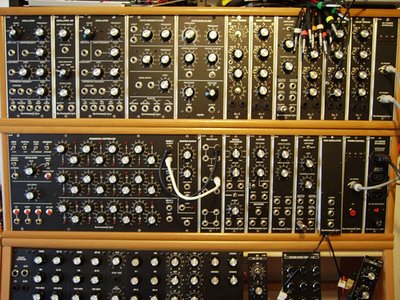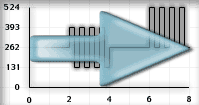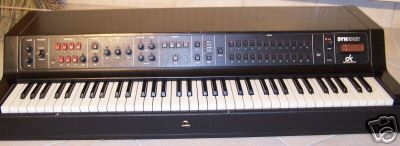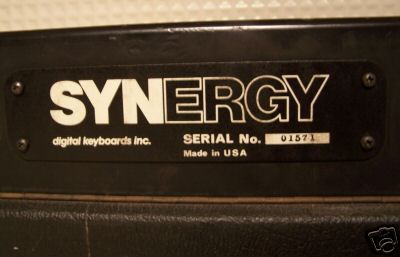 And there it is. Title link takes you to more info on Muff Wiggler.
And there it is. Title link takes you to more info on Muff Wiggler.
Thursday, January 18, 2007
New Korg MicroKorg
 Found this one on Chip Collection who found it on Gear Junkies. I can't seem to get to the link on Gear Junkies at the moment. Nothing at Korg yet.
Found this one on Chip Collection who found it on Gear Junkies. I can't seem to get to the link on Gear Junkies at the moment. Nothing at Korg yet.Update: Details are up.
Wednesday, January 17, 2007
Yamaha CS01
 Title link takes you to shots pulled via this auction.
Title link takes you to shots pulled via this auction.Details:
"This is a Yamaha CS01 Analog Synth. This is a monophonic synth(only 1 note at a time). These were only manufactured from 1982-1984.
This was the last analog synth Yamaha synth made according to most websites before moving to all digital with the DX-7. A very cool little synth with lots of sliders to play with. It has pitch bend and modulation wheels, breath control(if you can find one of those rare breath controllers). There are 5 waves to choose from as well as resonance. Everything works great and it's totally fun to play with. This may look like a toy, but it's got a lot of neat sounds to work with. By the way there is no memory to store sounds, so you have to move sliders to change the sounds, but it is easy to make up new sounds.It can use a DC9-12 power adapter with center pin postive, but it does not come with one, even though i tested to make sure it works. It also has a 1/4 inch headphone jack and a 1/4 output jack on the right side."
Don't forget MATRIXSYNTH-B for the b-sides.
John Arnold and Jeremy Ellis Live!!!
YouTube via defusionist. Title link takes you to more.
Features a Waldorf Micro Q Keyboard, Akai MPC, and Godin Guitar with MIDI.
FuzzyWuzzyModo
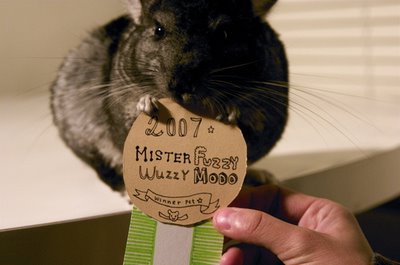 And the Chinchilla won.
And the Chinchilla won.If you are wondering why the heck I'm posting this. Click here.
They removed the number of votes, so who knows how much Moogy lost by.
D.A.M.I.A.N. DIY Modular
 Remember the Damian wooden modular? Here's another shot of it via sequencer.de I love the colors on it.
Remember the Damian wooden modular? Here's another shot of it via sequencer.de I love the colors on it.
KORG MiniKP
 "The family has expanded with its newest and smallest member, the mini-KP. It offers the same interface and realtime fingertip effects as other KAOSS models, plus many features taken from the new KP3, along with a compact body and battery operation for shirt pocket portability. Mini-KP is ideal for DJ club performances, home studio applications, as well as outdoor live events or for use with a portable audio player."
"The family has expanded with its newest and smallest member, the mini-KP. It offers the same interface and realtime fingertip effects as other KAOSS models, plus many features taken from the new KP3, along with a compact body and battery operation for shirt pocket portability. Mini-KP is ideal for DJ club performances, home studio applications, as well as outdoor live events or for use with a portable audio player."On Nova Musik's website. Via SIGHUP.
Arturia Origin Synthesizer
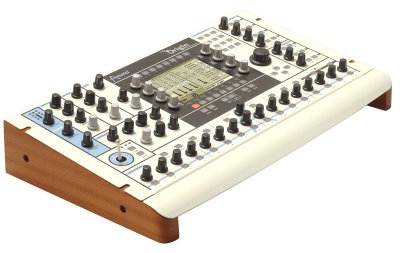 BE ORIGINAL
BE ORIGINALOrigin is the first Arturia Hardware synthesizer. It is a modular system of a new generation opening innovative avenues in sound design.
Loaded with modules extracted from the best synthesizers of all time (Moog Modular, ARP 2600, CS-80, minimoog and Prophet VS) Origin lets you combine these modules and benefit from the additional possibilities put onboard. The result: a new type of sound accessible through an extremely intuitive interface.
MAIN FEATURES:
* More than 500 presets created by talented musicians and synthesizer specialists
* Up to 32 voices of polyphony for a typical patch
* Create your own patch or use an existing audio structures: an Origin patch made by connecting independent modules, or the minimoog V, the ARP 2600, the CS-80, the Moog Modular.
* Superb audio quality with TAE® engine. 24 bits/96 kHz supported.
* Compatibility with most of the presets from the Arturia Classic virtual Analog synthesizers.
* Origin lets you open dedicated software on your Mac and PC and use it as an AU or VST plug-in. All the sounds are calculated on the machine while you work on your computer as you would do with a native application.
* Analog: 2 audio ins, 10 audio outs. Digital: SPDIF out, USB 2.0
* Large selection of effects: Phaser, Chorus, Delay, FX Reverbs, Distortion, Param Eq, Compressor, Bitcrusher
* 16/32 step sequencer
* Innovative Macro, Advanced LFO, modulation modes, Advanced Joystick modes.
* MIDI : In, Out, Thru or USB 2
Title link takes you there.
via diablo quapo
Arturia Does Roland
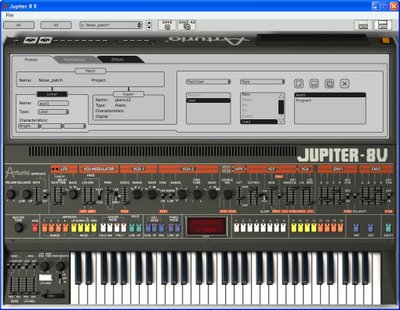 Introducing the Jupiter-8V
Introducing the Jupiter-8VCRYSTAL CLEAR PHATNESS
Arturia announces Jupiter 8V, the software recreation of Roland’s famous Jupiter 8 which was in production from 1981 to 1984. The Jupiter 8 was a synth that not only inspired a generation of musicians ranging from Prince to Howard Jones, from Depeche Mode to Moby, it was also a unique machine that offered a sharp and crystalline sound while being uniquely phat.
The Jupiter-8V is the latest born in the Arturia family of analog synthesizer recreations. Offering the unique sound palette of the Roland Jupiter 8 with a bass that can bring down the house.
Based on the latest version of TAE®, the Jupiter 8 V also brings to you an advanced step sequencer, a new line of dynamic effects and a module combining LFO’s called Galaxy. All in one, the Jupiter 8 V comes with a perfect blend of classicism and modernity.
MAIN FEATURES:
* More than 400 high quality and innovative sounding presets
* Up to 32 voices of polyphony, and a Unison mode
* A unique audio structure featuring 2 oscillators per voice (16 oscillators in total), 2 LFO’s, 2 filters and 2 envelopes.
* Keyboard split and layer
* A set of Analog Sounding Effects: Dual Delay, Phaser, Flanger, all three being largely modulable by any audio source in the synth.
* 2 digital effects, X and Y.
* Additional Live-oriented Step-sequencer, additional Galaxy module for advanced modulations
* Set to Control with your external MIDI keyboard in just a few clicks.
* Full compatibility with major formats and hosts on Mac OS X and Windows XP (VST, AU, RTAS)
Title link takes you there.
via diablo guapo
Nord C3 Combo Organ
 Title link takes you to a couple more shots.
Title link takes you to a couple more shots.The dual manual Nord C3 Combo Organ emulates three types of vintage organs carefully modeled from B3, Vox* Continental and Farfisa* Compact Deluxe originals.
Features ...
- Dual 61-note manuals, same keybeds as Electro 61
- New 2nd generation tonewheel organ model
- Two transistor organ models
- 3x vibrato, 3x chorus, unison function
- Tube-style overdrive
- Three types of amplifier simulations (including rotating speaker)
- Delay with tap-tempo
- Reverb (5 algorithms)
- 3-band EQ
- Louder outputs
- Dedicated bass pedalboard MIDI input
- Trek II String Bass emulation, with controls to activate sustained & "pluck" bass
Really cool features ...
11-pin rotary speaker connector - connect a Leslie, Motion Sound, or other rotary speaker with an 11-pin connection, and control it using the C3's rotary speaker controls; includes a high-level output & options for sending just the B3 to the external rotary speaker, and the transistor organs to an amp connected to the L & R 1/4" outputs
Half-Moon Switch accessory (optional) - a physical switch that takes the place of the panel controls for rotary speaker; controls external rotary speaker or internal emulation
33 pounds - yep, 33 pounds ...
Other:
Availability - shipping in the United States in April 2007 (subject to change)
Pricing - List $3,600
Accessories - Half-Moon Switch, Legs (same as Stage), music stand (same as stage), gig bag
"C3" - C = "combo", 3 = three organ models
via Katzenjammer
Jam: "It's a small world" for machines (mini-tour of studio)
And one more sent my way via shagghie.
"A rare mini tour of Shagghie's studio. Kind of like "it's a small world" for machines. I'm just letting them talk here...haven't done much to tame them or get them all to speak the same language, even if at the least they are all on the same clock. :)"
SunSyn meets Magneto-Tube Random Noise Gen!
Another sent my way via shagghie.
"Went by the surplus store today and scored a gem of a module...a vintage HH Scott model 811-B Random Noise Generator... This thing is sick. So of course I ran it through my SunSyn and let the noise modulate the LPF Cutoff Freq. Here's the lofi version..hifi version up shortly after. Thing has ASA, RF, AF, and LF noise modes...anyone know what those stand for?"
Update: Shagghie's MySpace Page
Post War Jam (Cyndustries Entry #1)
YouTube via shagghie.
"This mini performance came in 3rd place in the cyndustries.com 'War and Peace' bug music competition. Tries to capture the sorrow and distortion of life after WWIII, yet the need to still express no matter what the world's circumstance. All live, no samples, no loops. Wish camera mic picked up bass freqs better...the mp3 on Cynthia's site has 'proper' audio, fwiw.
Gear used:
MachineDrum fed through Micromoog filters.
MEK (2 seqences internal, 2 send via midi to SunSyn)
SunSyn - Pad sequence.
KP3- Used for grain delay treatment on treated MachineDrum beat through Micromoog.
Spectralis- Backbeat and light bass synth line
MEK - Dischorded bass line intro"
"For the curious: Ran some of the machinedrum through the micromoog's filter, while the MEK takes care of sequencing itself and one of the SunSyn voices. The Spectralis handles some backbeat and basic bass accents. I don't think a lot of folks realize just how powerful that micromoog can be in the hands of a noise freak. There's a 'pure' audio .mp3 on the Cyndustri's site, too: link"
Roland Jupiter 8 Resource Center
 Title link takes you to the archived site on web.archive.org. The site itself is gone. Makes you wonder how many other synth resource sites have gone to limbo. Fortunately web archives saves some of it for us.
Title link takes you to the archived site on web.archive.org. The site itself is gone. Makes you wonder how many other synth resource sites have gone to limbo. Fortunately web archives saves some of it for us. One of the reasons why I chose Blogger for Matrixsynth was because it is owned by Google and it runs on the Blogger servers, not my server. I don't have to deal with performance issues, costs (it's free!), and most importantly, the site will live on long after I'm gone.
BugBrand Drone Machine

Click here for images pulled via this auction.
Details:
"Input - Audio Input Preamp with Vari-decay Envelope Follower
The modular works at high signal levels so external audio signals must be brought up to suitable levels. Suitable for line or mic level signals (low or high gain settings respectively). The EnvFlw generates a smoothed CV representing the amplitude of the input signal.
RingMod - Multiplier / Modulator
Ring-modulation of oscillators or audio input results in some great klang-tones and you've got the modular scope to make the input waveforms do some interesting things. This module also allows amplitude modulation, so can be used for basic VCA applications in AM mode.
Inverters - CV / Audio inverters x 2
Two simple inverters that work with CV or audio signals. Useful for changing the polarity of modulation waves.
VCOs - 3 x Thomas Henry XR2206 VC(LF)Oscillator
These VCOs have some great power and with three of them you can reach some really extreme sonic areas by cross modulation and/or chaotic feedback. The concise design is from Thomas Henry (used with permission) - there are details online here and I've published a compact PCB for you to DIY here. I've added a switch to allow Oscillator or LFO ranges from about 1cycle a minute up to super-high frequencies (10+ kHz) and the oscillators are roughly scaled to 1v/oct (though I wasn't aiming for a typical keyboard driven synth system! You'll get at least four octaves of decent tracking).
The oscillator generates Sin/Tri waves (switchable) and squarewaves, has diverse modulation inputs, sync input and a strange/wonderful VC-waveshaping control that inverts half of the Sin/Tri waveform resulting in rich harmonics (the waveshaping doesn't change the squarewave)
The controls are (from top): Range Switch (Osc / LFO), Coarse Tune, Indicator LED, Fine Tune, Sin/Tri Switch, Waveshape, Exponential Modulation with depth control (use this input for 1v/oct response), Linear Modulation with depth control, Waveshape modulation with depth control, Sync input, Sin/Tri output, Square output.
VCF - State Variable VC Filter
A standard but powerful VC Filter design (12dB/Oct) with two audio inputs and three response outputs (Low / Band / High pass). There are controls for Cutoff and Resonance and two cutoff modulation inputs with depth controls. The two audio inputs (with level controls) are mixed together before the filter.
Delay - PT2399 digi-delay module (not voltage controlled).
The PT2399 is a good sounding digital delay chip - it is only specified to generate delays up to about half a second, but when you slow it down further you get some noisy, crunky, wonder sonics (hear the audio demos). You get two (switchable) time ranges - long or short, with long generating the crunchy sounds. Then there are controls for delay time, feedback (into overload) and dry/wet balance.
Output Mixer - 3 channel output mixer
A simple output mixer with level controls and master output level control.
The Rear Panel - Ins / Outs / Power / Decoration!
On the back of the unit you've got the input and output 1/4" mono unbalanced jack sockets, power input / on-off switch / LED indicators (bright blue!) and common ground connection (if you want to hook the unit to other modular devices). Pretty looking, no?
Connections - all internal connections use 4mm banana connections. These are great because they're colourful, reliable and, best of all, stackable - so you can take an output to many different inputs at the same time for modulationary overload.
Power - the box runs off a bipolar (+/- 12v) supply so you can only use it with the supplied AC (not DC!) power adaptor. I have a range of AC adaptors suitable for your global location and will supply your choice of UK, Euro or US.
Case - the box is a compact 12 x 6 x 6 inches and has a carrying handle on top. Damn, you can travel in style with this box - it looks kind of like a vanity case!
Sound Demos - an important factor! Here are some mp3 demos (320 kbps) - they are all recorded straight in with zero effects - what you hear is what you get! And do try to listen on decent speakers to hear the extreme low-frequencies possible. These sounds, of course, give only a brief overview of the sonic possibilities."
Demo1 - starts with slowly modulated oscillations, moves through some delay sounds and down into clickety bubbles.
Demo2 - some synthy sounds (not played with keyboard! purely square-wave modulation depth), more delay and then into a chaotic scream section. Finishes with some hyper-high-freq slow moves to cleanse your ears.
Demo3 - audio processing with a drum beat. Highlights the VCF with modulation from the EnvFlw and oscillators. Moves into ringmod sounds and the end has some subtle sync'ing rhythmics.
Demo4 - Low-end sine modulations - you need to hear the lows. Shows some waveshaping and modulation inversion."
You can find the demo links in the auction and mirrored here for when the auction goes away.
Previous BugBrand posts including video.
BugBrand on YouTube
BugBrand website
Update: The video:
BugBrand Drone Machine - Overview & Audio Processing Demo
Casio PT-10
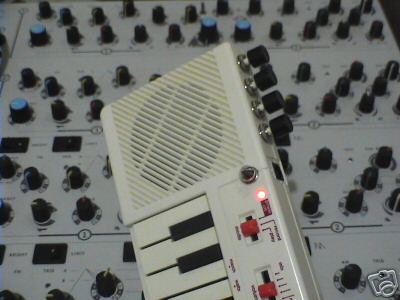 Another "made you look" auction image. This one features what looks like a Quad Sherman Filterbank. The auction is for the Casio PT-10. Title link takes you to the shots pulled via this auction. I have a feeling these are going to get old pretty fast, but it's interesting seeing this technique for the first time. This is via the same seller as the last post.
Another "made you look" auction image. This one features what looks like a Quad Sherman Filterbank. The auction is for the Casio PT-10. Title link takes you to the shots pulled via this auction. I have a feeling these are going to get old pretty fast, but it's interesting seeing this technique for the first time. This is via the same seller as the last post.Details:
"HARDCORE PUNK CIRCUIT BENT CASIO PT-10. FOUR BLACK MOMENTARY BUTTONS UNDER YOUR FINGERS & ONE TOUCH SENSITIVE STUD THAT INDUCES PITCH SWOOPING FOR LEFT HAND MANIPULATION. THESE BUTTONS ARE SUPER HIGH QUALITY FOR CLEAN ENGAGEMENT OF BENDS AND FEATURE A SMOOTH SPRINGY REBOUND. THE STUD IS UNSHARPENED APPAREL QUALITY AND IS SOLIDLY MOUNTED AND RE-ENFORCED SO YOU CAN WAIL ON IT. ADDED 1/8 INCH OUTPUT FOR MIXERS, EFFECTS... I HAVE BEEN PLUGGING STRAIGHT INTO MY MODULAR SYNTH AND USING IT AS A SOUND SOURCE OR FURTHER BLASTING WITH THE SHERMAN FILTERBANKS I USE SO OBSESSIVELY... GOOD SOLID MODIFIED DEVICE WITH LOADS OF ATTITUDE AND AGGRESSIVE SOUNDS AND RHYTHMS AS WELL AS THE STOCK PIANO, FANTASY, VIOLIN & FLUTE PRESETS. ALL THE BENDS WORK INDEPENDENTLY AND IN COMBINATION WITH ONE ANOTHER FOR VARIOUS RESULTS WITH VARIOUS VOICE, RHYTHM, AND OTHER SETTINGS ON THIS KEYBOARD. PORTABLE; THE PT-10 WORKS WITH 4 AA BATTERIES & THE BATTERY COMPARTMENT IS CLEAN, UNOBSTRUCTED; THE COVER INTACT... ...& IT WILL RUN OFF OF THE 6v DC ON THE MULTI-VOLTAGE MULTI-ADAPTOR I AM INCLUDING IN THIS AUCTION ! THE SPEAKER IS INTACT AND PRODUCES LOUD CLEAR SOUND THAT IS NOT SIMPLY OVERDRIVEN INTO DISTORTION BY THE BENDS."
That's not me shouting, btw...
Magical Musical Thing

File this one under one of the best "made you look" Ebay auctions. I'm going through the newly listed stuff and I see a thumbnail of this image listed as "Magic Musical Thing." You can barely make out the image in the thumbnail but I see lots of colors and lights, so of course I click. And... It's a Hartmann Neuron! Only the Neuron of course is not up for auction, but rather... the "Magical Musical Thing"
No title link. Just the two shots and some details pulled via this auction.
 Details:
Details:"RARE MATTEL 1978 MAGICAL MUSICAL THING. THIS SYNTH WAS MARKETED AROUND THE TIME OF THE HIGHLY SUCCESSFUL MOTION PICTURE 'CLOSE ENCOUNTERS OF THE THIRD KIND' & MAY HAVE BEEN AN ATTEMPT TO CAPITALIZE ON THE MARRIAGE OF COLOR AND SOUND THAT COMPRISED COMMUNICATIONS BETWEEN THE HUMAN AND TERRESTRIAL IN THAT FAMOUS FILM'S FINALE SEQUENCE... VERY GOOD FULY FUNCTIONING CONDITION DESPITE THE LOSS OF THE MATTEL LOGO AND OTHER ADORNMENTS. COMES WITH BOX AND BOOKLET OF INSTRUCTIONS AND SONGS. STRANGE BEAUTY AND PROBABLY A WONDERFUL CANDIDATE FOR A CIRCUIT BENDING PROJECT... WILL BE ABOUT 5lbs. PACKAGED"
Apologies for the all caps, but I'm not about to convert that to lower case.
Roland SH-1000
 Title link takes you to shots pulled via this auction.
Title link takes you to shots pulled via this auction.Details:
" This is a Roland SH-1000 synth. It is the first synth Roland produced and possibly one of the first commercial Japanese synths, which makes it quite a collectible.
It has 10 preset sounds and a synth section for creating your own sounds. On the synth section there are 9 synth selectors giving a range from 32' to 2' each of which can be combined for generating more complex waveforms. It also has a VCF and VCA. Effects include Vibrato, Tremelo, Portamento, Glide, Growl, Waw and Random Note which plays "accidental" random notes, interesting effect. There is also White and Pink noise. It's got pretty much everything. Spend a little time with it and you will be soon producing some very cool and unique basses, leads and weird sounds.
It has a nice rich analog sound and has some very interesting modulation features not found on the later SH models."
Don't forget to check out MATRIXSYNTH-B for more.
Tuesday, January 16, 2007
FLAME at NAMM
 Remember FLAME? Looks like it will be making an appearance at NAMM.
Remember FLAME? Looks like it will be making an appearance at NAMM.Title link takes you to the FLAME site with audio.
Producer Timbaland rips song from finnish musician?
YouTube via timbalandrips. Sent my way via JM.
"In 2000 the Finnish demoscene musician Janne Suni (also known as 'Tempest') won the Oldskool Music Competition at the Assembly demoparty with his four-channel Amiga .MOD entitled 'Acid Jazzed Evening.' A Commodore 64 musician called 'grg' remade the song on the C64 (using the infamous SID soundchip); it is this that was stolen."
Synth content: C64 in the original track. Title link takes you to non synth details.
There's more detail in the description of the YouTube video.
Here's the TinyUrl referenced at the end of the video.
Jupiter 8 Versions
This came in on the AH list. Bookmarking this one for future reference.
According to the service manual there are NINE different versions:
Below 171700: OC-8 (optie) test production
171700 - 181899: D/A converter from 12 to 14 bit
---: OC-8 is optional for 12 en 14 bit models
181900: PROM compatibel with OC-8 PROM's
202100: Modulation circuit
202210: RAM Module Controller Board
242750: Brighter leds installed
272850: Button added to dimm Leds
282880: DCB Board standard
NB: the OC-8 board was the predecessor of the DCB Board
Update: Table of serial numbers.
According to the service manual there are NINE different versions:
Below 171700: OC-8 (optie) test production
171700 - 181899: D/A converter from 12 to 14 bit
---: OC-8 is optional for 12 en 14 bit models
181900: PROM compatibel with OC-8 PROM's
202100: Modulation circuit
202210: RAM Module Controller Board
242750: Brighter leds installed
272850: Button added to dimm Leds
282880: DCB Board standard
NB: the OC-8 board was the predecessor of the DCB Board
Update: Table of serial numbers.
x0xb0x Mod and Mp3
Virus TI OS 2.0 - Grain-table Synthesis?
 Title link takes you to a pdf via this thread on HC.
Title link takes you to a pdf via this thread on HC."OS 2.0 for Virus TI has some new oscillator types:
"The new version features additional oscillator types, enhanced Wavetable synthesis and more wavetables. It allows you to see how expensive a chosen patch is and features Section Locking through Virus Control. Patches can be finally sorted by category and the onboard patch ROM contains addition 256 sounds by Matthew Stolley and Matt Picone.
We have included new oscillator modes, greatly expanding on the flexibility of these already powerful sound-sculpting tools.
The remaining oscillator modes all make use of a new technology for the Virus TI, called Grain Table. The basic idea behind this technology, is to take the existing wavetables, and apply similar techniques as those used in some granular sampling and pitch-shifting algorithms to open up a whole new world of possibilities. Each of the two main types: Grain Table and Formant Table are presented in both Simple and Complex formats. In each case, the Simple mode offers fewer parameters, and a higher polyphony than Complex, with the values of parameters common to each mode remaining constant.
It’s important to note that the characteristics of the Grain Table and Formant Table oscillators are quite different to those of traditional “granular” sampling/synthesis techniques, which tend to be associated with other-worldly “clouds” of sound. In the Virus TI, we have instead employed the technology to achieve a very musical result which should prove every bit as useful as the other oscillator types in all manner of musical projects."
I have no idea if this is real, but there it is.
Wiard Envelop MARF Model GR-1214A
 Multiple Arbitrary Function Generator
Multiple Arbitrary Function Generatorflickr by M.M.
Title link takes you to more info on Muff Wiggler.
Details via Grant Richter of Wiard:
"After years of design and months of work I have a kind of working prototype of the Envelooper MARF. It works, but not perfectly yet. I am still getting the bugs out. This is targeted to the Frac-Rac format.
MARF stands for "Multiple Arbitrary Function Generator". One of the shortcomings of modular synthesis is the lack of complex controllers for modules. To generate a complex control function now, you have to sum together multiple envelopes and LFOs. The Envelooper allows you to draw complex control functions visually, with enough points to reproduce the effect of summing multiple envelopes and LFOs. It also stores pitches like a sequencer, and you can draw an envelope in channel 4 for each pitch.
The Envelooper is designed to support true "gestural" synthesis where a single key press or button push can produce control signals for a complete musical gesture. Multiple gestures are stored in different Banks and can be selected by voltage control. Using a black and white keyboard, you can select and trigger gestures with just the keyboard. The Envelooper also has a "Loop" switch that sets it to free running loop without needing a gate or trigger.
The Envelooper is modeled after an ADSR envelope generator. For the Envelooper, each segment of the A, D, S and R is four 256 byte pages stored in a PROM, for a total of 1024 bytes for each envelope. Four 8 bit outputs are produced simultaneously with a channel to channel skew of an inaudible 1 microsecond.
Each ADSR segment has an independent "playback" time control from 1 millisecond to 20 seconds. The shortest total envelope time is 4 milliseconds and the longest is 80 seconds.
The ouputs are calibrated like the Mini-Wave to 1 volt per octave. Two steps = 83.3 millivolts = a semitone. So the table programmer in Wave 256 can be used to program pitch information using actual note names.
The Wave256 software used to program the Waveform City and Mini-Wave is also used to program the Envelooper. The waveforms in a "Wave" are set up like this for the enveloopers four outputs; A1, A2, A3, A4, D1, D2, D3, D4, S1, S2, S3, S4, R1, R2, R3, R4.
The programming rules are as follows; A(ttack) pages start at -128 and end at +128, D(ecay) pages start at +128 and end at 0, S(ustain) pages start and end at zero, Release pages start at 0 and end at -128. Following these programing rules produce envelopes with no audible "splice" when the device switches from one segment to another.
The four outputs are mapped two different ways for East Coast and West Coast patches. For East Coast use, output 1 controls the pitch of the VCO, output 2 controls the waveform, output 3 controls the VCF (Boogie) and output 4 controls the VCA (Borg 2). For West Coast use, output 1 controls the pitch of the VCO, output 2 controls the waveform X, output 3 controls the waveform Y and output 4 controls the lowpass gate.
8 bits has a fair amount of zipper noise, for pitches we want this quantization, but it is a problem for VCAs and other inputs. One of the little known things about Vactrols is that they remove zipper noise. So running an 8 bit signal through a Vactrol smooths out the steps into continuous function. The VCO will have Vactrols or the equivalent on the waveform X and Y inputs to remove zipper noise. The Borg and Boogie filters are based on Vactrols and already remove zipper noise.
I just wanted to post a little note to let everyone know that Wiard R&D will continue to produce ground breaking designs not available anywhere else. For those REALLY interested I have posted the test PROM file in the files section called adsr4.256 Use the Wave256 software to view the segment designs. Please note this is just an experimental file to test ideas, NOT the final file which will ship with the module."
Again, check out Muff Wiggler for more module mayhem.
Pair O' Slopes
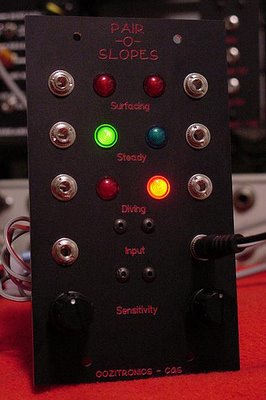 flickr by M.M.
flickr by M.M.Title link takes you to more info on Muff Wiggler. Check out Muff Wiggler for other modules.
Plan B at Winter NAMM 2007

Click image for full shot.
Model 21 Milton Venti (The new Milton has arrived)
Model 25 Multi-tasking Audio Processor
Model 26 Multi-tasking Control Processor
Model 27 Digital Delay
Model 16 Spectral Multiplexer
Booth 1785
Go here for an audio preview
This is the first I've heard of the Model 25, 26 and 27.
This is the first showing of all five in their finished form.
Title link takes you to ear.
Previous Plan b posts
Previous Milton posts
Previous Model 21 post
Previous Model 16 posts
Light Show
 Title link takes you to a 1.83M mp3 by daddio of Tapewarm Studio.
Title link takes you to a 1.83M mp3 by daddio of Tapewarm Studio. "some testing noise (not very musical): doepfer modular/MAQ (super simple patch), kaoss pads, and nord rackII/expressionmate"
Monday, January 15, 2007
Metasonix Video Update
There's a longer version of the video I put up in the previous post. If you already watched it, the new lofi video is worth checking out as there's a bit more to it.
Metal Banjo Mashup
 Remember this post? Title link takes you to a wicked 4.83M mp3 mashup via Doktor Future. If I remember correctly Doktor Future was the person who claimed all 200e samples sounded like a banjo.
Remember this post? Title link takes you to a wicked 4.83M mp3 mashup via Doktor Future. If I remember correctly Doktor Future was the person who claimed all 200e samples sounded like a banjo. If Tom Waits had a banjo, this is what it would sound like.
mirrored here
Update: I put this post up after reading the comments of this post. I just checked my email and found an email from Doktor Future with a link to the mp3 and this better quality WAV along with, "I'm including a graphic to go with the post (if you want to post it). The graphic, appropriately, has nothing to do with anything." Works for me. : ) Somehow the image actually seems appropriate - you're going to want to use it after listening to this.
electro-music 2007
Video of electro-music 2006 to give you an idea about the event coming up in 2007. Title link takes you to more info on electro-music 2007.
metasonix wretch machine hifi
Update: I accidentally put up the video labeled hifi thinking it was the same video as the lofi. It's not. Here's the lofi vid. Title link takes you to the hifi. the hifi is considerably shorter, so watch this one.
YouTube via companyofquail.
"this is just a simple 16 step sequence from a mobius driving the metasonix wretch machine starring me turning knobs and the wretch machine making noises."
Note that companyofquail brought us these excellent Genoqs Octopus videos.
Musicians and DIY Electronics Swapmeat
 In Gilmans, Berkeley CA.
In Gilmans, Berkeley CA.I see a Novation BassStation and Casio CZ-101?
Looks just like one of my synth dreams...
The event was put on by Euthymia Electronics.
Title link takes you to the set. via gerald.
Two Synth Classics up for Auction
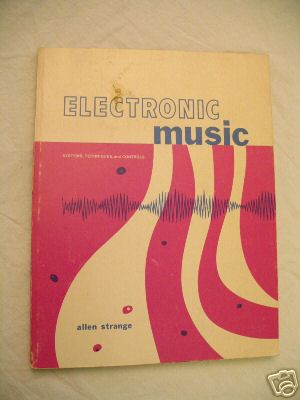
Electronic Music by Allen Strange
Details:
"Analog Synthesis Textbook: ELECTRONIC MUSIC - SYSTEMS, TECHNIQUES & CONTROLS by Allen Strange 160 pages, copyright 1972, 10th printing, 1980."

Synthesizer Technique
Details:
"Bob Moog, Tom Coster, George Duke, Roger Powell and other experts offer practical,creative instruction on how to master the technical and artistic potential of your synthesizer. Volume II in the Keyboard Synthesizer Library. 113 pages, 1984."
Auctions via 123Synthland aka Minime123. Title link takes you to more items up for auction via 123Synthland.
Previous 122Synthland posts
TB3030 - Roland TB-303 Clone
 You don't see these often. Oakley TB3030. No title link just the two shots via this auction sent my way via Evil Paul.
You don't see these often. Oakley TB3030. No title link just the two shots via this auction sent my way via Evil Paul.Details:
"This is a TB3030 synth, which is basically an exact copy of the classic Roland TB 303 synth engine with a few extra enhancements, but without the sequencer.
I always wanted to get that classic analog 303 sound but didn't want to fork out the cash ($$$!) for an original Roland TB 303. I came across a guy on the internet who went to a massive amount of trouble to copy the 303 circuit exactly, add some extra features, and print some new circuit boards for it. I bought a circuit board from him, sourced all the parts (some were very hard to find!) then constructed it (I'm an electronic engineer). I worked on it every night for a month to build it, and it worked reasonably expensive to get all the parts for it.
I also built a midi interface into it, so it can be controlled by any external midi keyboard, or a sequencer such as a computer running Cubase.
It also includes a number of mods to the original 303 synth engine (in the vein of the devilfish mods), which make it more versatile as a synth. It includes a balanced output, an overdrive/distortion circuit, filter FM, a sub octave generator, VCA decay control and an accented decay control, all of which are not included on the original 303.
It certainly has an awesome tone! You can download some samples (and other info for it) from this page: http://www.oakleysound.com/tb3031.htm. Note that these sound samples are for the newer version (TB3031) which is slightly different, however the guts are basically the same and mine sounds basically the same.
Looking at the front panel, it has the following controls:
* Tune
* FM Modulation
* VCO Waveform select
* FM Wave Select
* Slide
* Filter cutoff frequency
* Filter resonance
* Accent
* Accent Decay
* VCF Envelope
* VCF Envelope Decay
* Sub oscillator (adds extra bass an octave down for a really fat sound)
* Mod wheel control (from memory this is mapped to filter cutoff, allowing you to control the filter frequency directly from your keyboard or sequencer)
* Drive (distortion circuit that really makes this thing bark)
* VCA Decay
* Processor control on/off (allows slide and accent to be controlled with midi velocity)
* Volume
On the back it has Midi in and Midi thru connectors, signal out and filter input jack, and the power connector. It has been built into a 3 unit rack case."

Previous TB3030 posts
Previous Oakley posts
Top 20 Greatest Synths - Feb. 14th 2007
Re-Published on Mar 4, 2016
Via Sonic State.
"The long awaited IPTV series The Top 20 Greatest Synths will be going live here at Sonic on Wednesday February 14, 2007. Each of the 8 episodes broadcasted once a fortnight, will be around 10 minutes long and feature 3 chart positions with full length episodes for the number 2 and number 1 slots later in the series. The entire programme will then be posted in the Spring as one contiguous show.
Each episode has footage, facts and features about the greatest electronic instruments ever produced as well as interviews with the people who made ‘em and the people who played ‘em. It’s basically a big fat excuse to rant about all-things-synth in a show that aims to be witty, passionate, respectful and shamelessly nostalgic about electronic music, circuit boards, the 1980’s, resistors, wood finishes, keyboards with knobs on and everything in between."
Title link takes you to more info.
Fairlight on YouTube
Bob Moog Fairlight Intro
"Dr Moog demos the Fairlight CMI 1983"
Fairlight Keith Emerson
"1983 Today Show with Keith Emerson and the Fairlight CMI"
YouTubes via jhanalog.
Via Failed Muso. Check out Failed Muso for some more videos including Vince Clarke.
"Dr Moog demos the Fairlight CMI 1983"
Fairlight Keith Emerson
"1983 Today Show with Keith Emerson and the Fairlight CMI"
YouTubes via jhanalog.
Via Failed Muso. Check out Failed Muso for some more videos including Vince Clarke.
Akai AX60 With Wood Side Panels
 Title link takes you to shots pulled via this VSE thread listing it for sale by Altitude.
Title link takes you to shots pulled via this VSE thread listing it for sale by Altitude.
PREVIOUS PAGE
NEXT PAGE
HOME













© Matrixsynth - All posts are presented here for informative, historical and educative purposes as applicable within fair use.
MATRIXSYNTH is supported by affiliate links that use cookies to track clickthroughs and sales. See the privacy policy for details.
MATRIXSYNTH - EVERYTHING SYNTH













© Matrixsynth - All posts are presented here for informative, historical and educative purposes as applicable within fair use.
MATRIXSYNTH is supported by affiliate links that use cookies to track clickthroughs and sales. See the privacy policy for details.
MATRIXSYNTH - EVERYTHING SYNTH
